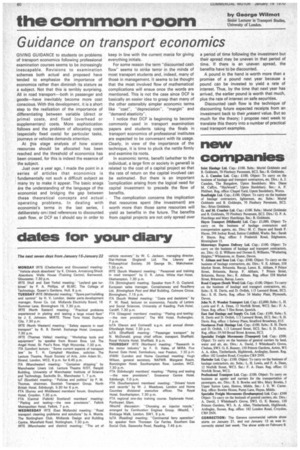the common room
Page 62

If you've noticed an error in this article please click here to report it so we can fix it.
Guidance on transport economics
GIVING GUIDANCE to students on problems of transport economics following professional examination courses seems to be increasingly inescapable. Revisions to examination schemes both actual and proposed have tended to emphasize the importance of economics rather than diminish its stature as a subject. Not that this is terribly surprising. All in road transport-both in passenger and goods-have inevitably become more cost conscious. With this development, it is a short step to the realization of the importance of differentiating between variable (direct or prime) costs, and fixed (overhead or supplementary) costs, More sophistication follows and the problem of allocating costs (especially fixed costs) for particular tasks, journeys or vehicles demands attention.
At this stage analysis of how scarce resources should be allocated has been reached and the threshold of economics has been crossed, for this is indeed the essence of the subject.
Just over a year ago, I made the point in a series of articles that economics is fundamentally not such a difficult subiect as many try to make it appear. The basic snags are the understanding of the language of the economist and bridging the gap between these theoretical concepts and actual operating problems. In dealing with economist's terms in the last series, I deliberately am i tted references to discounted cash flow, or DCF as I should say in order to
keep in line with the current mania for giving everything initials.
For some reason the term "discounted cash flow" seems to strike terror in the minds of most transport students and, indeed, many of those in management. It seems to be thought that the most involved flow of mathematical complications will ensue once the words are mentioned. This is not the case since DCF is basically an easier idea to grasp than many of the other ostensibly simpler economic terms like "cost'', "depreciation", ''margin" and "demand elasticity".
I notice that DCF is beginning to become commonly used in transport examination papers and students taking the finals in transport economics of professional institutes are expected to be conversant with its usage. Clearly, in view of the importance of the technique, it is time to pluck the nettle firmly and examine its roots.
In economic terms, benefit (whether to the individual, a large firm or society in general) is related to the cost of a capital project so that the rate of return on the capital involved can be estimated, But there is an important 'complication arising from the logical need for capital investment to precede the flow of benefits.
The complication concerns the implication that resources spent (the investment) are worth more than those same resources will yield as benefits in the future. The benefits from capital projects are not only spread over a period of time following the investment but their spread may be uneven in that period of time. If there is an uneven spread, the benefits have to be discounted. .
A pound in the hand is worth more than a promise of a pound next year because a pound can be invested to yield a rate of interest. Thus, by the time that next year has arrived, the earlier pound is worth that much, plus the rate of interest on safe securities.
Discounted cash flow is the technique of discounting future expected receipts from an investment back to their present value. But so much for the theory; I propose next week to translate this theory into a number of practical road transport examples.
































































































